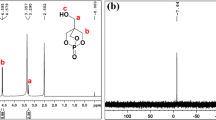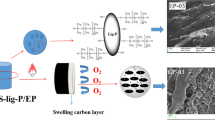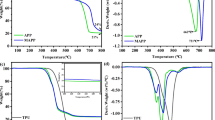Abstract
With the increasing use of thermoplastics and thermosetting polymers on a large scale for applications in buildings, transportation, electrical engineering and electronics, as well as the high fires safety standards which polymer resins should meet, a large variety of flame retardant products have been developed over the past 40 years. Restrictions on the use of polybrominated diphenyl ethers (PBDE) have resulted in the increased use of alternate flame retardant chemicals, such as phosphorus flame retardants (PFR). PFR contains a wide group of different organic and inorganic compounds, with a great variation in their physico-chemical properties. They are non-flammable, non-explosive and odorless substances listed as High Production Volume Chemicals (HPV). Non-halogen, phosphorus-containing flame retardants such as ammonium polyphosphate and red phosphorus are shown to be very effective in thermoset resins. Phosphate esters significantly lower the heat distortion temperature and impact properties of PC/ABS blends while increasing melt flow in so called antiplasticization process. Resorcinol diphosphate (RDP) was the first material developed for PC/ABS and it is a liquid additive with 9 % P content and good efficacy as a flame retardant. Bisphenol A bisphosphate (BADP) is another liquid with properties similar to RDP. Polymer–clay nanocomposites have attracted a great deal of interest due to their improved mechanical, thermal and biodegradability properties. Nano “sponge” structures produced from cyclodextrins have been tested with flame retardants ammonium polyphosphate (APP) and triethylphopshate. The PFRs can be enclosed in the nano sugar sponge structure, improving mixing with plastic polymers and enabling high flame retardant loadings without deteriorating polymer mechanical performance. Fire performance tests using the nano sugar sponge—PFR combination (heat release, heat of combustion, mass loss, smoke) showed that the combination was effective for environmentally friendly structures polypropylene, linear low density polyethylene and polyamide 6.
Access this chapter
Tax calculation will be finalised at checkout
Purchases are for personal use only
Similar content being viewed by others
References
SRI Consulting.: Consumption of flame retardants. http://www.cefic-efra.com 7 (2004). Accessed 27 May 2005 (La Rosa et al. 1999, Pecht et al. 1994)
La Rosa, D., Recca, A., Carter, J.T., Mc Grail, P.T.: An oxygen index evaluation of flammability on modified epoxy/polyester systems. Polymer 40(14), 4093–4098 (1999)
Pecht, M., Nguyen, L.T., Hakim, E.B. (eds.): Plastic Encapsulated Microelectronics. Wiley, New York (1994)
de Wit, C.A.: An overview of brominated flame retardants in the environment. Chemosphere 46(5), 583–624 (2002)
Bromine Science and Environmental Forum.: An introduction to brominated flame retardants, October 2000. http://www.ebfrip.org/download/weeeqa.pdf (2000)
European Commission.: Directive 2002/95/EC of the European Parliament of 27.01.2003 on the restriction of certain hazardous substances in electric and electronic equipment (2003)
European Flame Retardants Association, EFRA.: Market Statistics. http://www.flameretardants.eu/DocShareNoFrame/docs/1/HGJJCNFBPCEOKPEPPIPEICDF53V443-HA4YW3PDB348BT/EFRA/docs/DLS/EFRA_web_11-2007_Market_statistics-1.pdf (2007)
International Uniform Chemical Information Database.: IUCLID, 2nd edn. [CD-ROM]; CB, European Chemicals Bureau, Ispra, Italy (2000)
European Commission.: EU risk assessment report, tris(2-chloro-1-methylethyl) phosphate, TCPP (2008)
European Commission.: EU risk assessment report, tris(2-chloro-1-(chloromethyl)ethyl) phosphate, TDCP (2008)
European Commission.: EU risk assessment report, tris(2-chloroethyl) phosphate, TCEP (2009)
Latendresse, J.R., Brooks, C.L., Capen, C.C.: Pathologic effects of butylated triphenyl phosphate-based hydraulic fluid and tricresyl phosphate on the adrenal gland, ovary, and testis in the Fischer-344 rat. Toxicol. Pathol. 22, 341–354 (1994)
Steukers, V., Kroon, S., Drohmann, D.: Flame retardants: European Union risk assessments update. Plast. Addit. Compd. 6, 26–29 (2004)
Rodriguez, I., Calvo, F., Quintana, J.B., Rubi, E., Rodil, R., Cela, R.: Suitability of solid-phase microextraction for the determination of organophosphate flame retardants and plasticizers in water samples. J. Chromatogr. A 1108, 158–165 (2006)
Hendrickx, A.G., Peterson, P.E., Tyl, R.W., Fisher, L.C., Fosnight, L.J., Kubena, M.F., Vrbanic, M.A., Katz, G.V.: Assessment of the developmental toxicity of 2-ethylhexanoic acid in rats and rabbits. Toxicol. Sci. 20, 199–209 (1993)
Sakon (to Rinkagaku Kogyo).: Red phosphorus flame retardant and nonflammable resinous composition containing the same. US Patent 4,879,067, 7 Nov 1989
Peters, E.N.: Flame-retardant thermoplastics I: polyethylene-red phosphorus. J. Appl. Polym. Sci. 24(6), 1457–1464 (1979)
http://cellulartechnology.us/flame-retardant-plasticizers-pu-vinyl/
Wang, Z., Wu, G., Hu, Y., Ding, Y., Hu, K., Fan, W.: Thermal degradation of magnesium hydroxide and red phosphorus flame retarded polyethylene composites. Polym. Degrad. Stab. 77, 427–434 (2002)
Pecht, M., Deng, Y.: Electronic device encapsulation using red phosphorus flame retardants. Microelectron. Reliab. 46, 53–62 (2006)
Muir, D.C.G.: Phosphate esters, In: Huntzinger, O. (ed.) Handbook of Environmental Chemistry. Springer, Berlin (1984)
World Health Organization, WHO.: Tributyl Phosphate. Environmental Health Criteria, vol. 112, Geneva, Switzerland (1991)
World Health Organization, WHO.: Flame Retardants: Tris(2-butoxyethyl) Phosphate, Tris(2-ethylhexyl) Phosphate and Tetrakis(hydroxymethyl) Phosphonium Salts. Environmental Health Criteria, vol. 218, Geneva, Switzerland (2000)
International Programme on Chemical Safety, IPCS.: Flame Retardants: Tris(2-Butoxyethyl) Phosphate, Tris (2-Ethylhexyl) Phosphate and Tetrakis(Hydroxymethyl) Phosphonium Salts. Environmental Health Criteria, vol. 218. World Health Organization, Geneva, Switzerland (2000)
Anderson, C., Wischer, D., Schmieder, A., Spiteller, M.: Fate of triphenyl phosphate in soil. Chemosphere 27, 869–879 (1993)
Kera, Y., Takahashi, S., Abe, K.: Biodegradation of persistent chlorinated organophosphorus flame retardants by microorganisms newly isolated from soil—a short review. Trans GIGAKU 1(01011), 1–4 (2012)
Takahashi, S., Abe, K., Kera, Y.: Microbial degradation of persistent organophosphorus flame retardants. In: Petre, M. (ed.) Environmental Biotechnology—New Approaches and Prospective Applications. InTech. ISBN:978-953-51-0972-3, doi:10.5772/53749. Accessed http://www.intechopen.com/books/environmental-biotechnology-new-approaches-and-prospective-applications/microbial-degradation-of-persistent-organophosphorus-flame-retardants (2013)
Kolvenbach, B., Schlaich, N., Raoui, Z., Prell, J., Zühlke, S., Schäffer, A., Guengerich, F.P., Corvini, P.F.X.: Degradation pathway of bisphenol a: does ipso substitution apply to phenols containing a quaternary α-carbon structure in the para position? Appl. Environ. Microbiol. 73(15), 4776–4784 (2007)
Andresen, J., Grundmann, A., Bester, K.: Organophosphorus flame retardants and plasticisers in surface waters. Sci. Total Environ. 332, 155–166 (2004)
Reemtsma, T., Quintana, J.B., Rodil, R., Garcıa-Lopez, M., Rodrıguez, I.: Organophosphorus flame retardants and plasticizers in water and air I. Occurrence and fate. Trends Anal. Chem. 27, 727–737 (2008)
http://www.pinfa.org/non-halogenated-pin-frs/phosphorus-based-flame-retardants.html
Agency for Toxic Substances and Disease Registry, ATSDR.: Toxicological Profile for Hydraulic Fluids. U.S. Department of Health and Human Services, Atlanta, GA (1997)
van der Veen, I., de Boer, J.: Phosphorus flame retardants: properties, production, environmental occurrence, toxicity and analysis. Chemosphere 88, 1119–1153 (2012)
Pakalin, S., Cole, T., Steinkellner, J., Nicolas, R., Tissier, C., Munn, S., Eisenreich, S.: Review on Production Processes of Decabromodiphenyl Ether (decaBDE) Used in Polymeric Applications in Electrical and Electronic Equipment, and Assessment of the Availability of Potential Alternatives to decaBDE, European Report EUR 22693 EN. Brussel, Belgium (2007)
Leisewitz, A., Kruse, H., Schramm, E.: Substituting Environmentally Relevant Flame Retardants: Assessment Fundamentals. Results and Summary Overview. Environmental Research Plan of the German Federal Ministry for the Environment, Nature Conservation and Nuclear Safety. Research, Report 297 44 542 (2000)
Pawlowski, K.H., Schartel, B.: Flame retardancy mechanisms of triphenyl phosphate, resorcinol bis(diphenyl phosphate) and bisphenol A bis(diphenyl phosphate) in polycarbonate/acrylonitrile–butadiene–styrene blends. Polym. Int. 56, 1404–1414 (2007)
Chemspider.: http://www.chemspider.com/Search.aspx (2011). Accessed 31 Oct 2011
U.S. EPA.: EPI Suite. [computer program]. Version 3.11.: U.S. Environmental Protection Agency (EPA) Office of Pollution Prevention Toxics and Syracuse Research Company (SRC), Washington, D.C. (2003)
Verbruggen, E.M.J., Rila, J.P., Traas, T.P., Posthuma-Doodeman, C.J.A.M., Posthumus, R.: Environmental Risk Limits for Several Phosphate Esters, with Possible Application as Flame Retardant. National Institute for Public Health and the Environment, Bilthoven (2005)
World Health Organization (WHO).: EHC 110: Tricresyl Phosphate, Geneva, Switzerland (1990)
Tremain, S.P.: TCPP Determination of Vapour Pressure. SPL Project Number 1613/001 (2002)
Cuthbert, J.E., Mullee, D.M.: TCPP: Determination of General Physicochemical Properties. Report 1613/002, Safe Pharm Laboratories, PO Box 45, Derby, UK (2002)
European Commission.: EU Risk Assessment Report, 2,2-Bis(Chloromethyl) Trimethylene Bis[bis(2-Chloroethyl) Phosphate] (V6) CAS No.: 38051-10-4. EINECS No.: 253-760-2 (2008)
ASCC (Australian Safety and Compensation Council).: Melapur 200 and Polymer in Exolit OP 1312. National Industrial Chemicals Notification and Assessment Scheme. Full Public Report (2006)
Phosphorus, Inorganic and Nitrogen Flame retardant Association (PINFA).: Human Health and Environmental Fact Sheet, MELAPUR 200 70. Accessed 20 Sept 2011
Organisation for Economic Co-operation and Development, OECD.: Emission Scenario Document on Plastics Additives (OECD Series on Emission Scenario Documents No 3, ENV/JM/MONO/8) (2004)
Fries, E., Püttmann, W.: Occurrence of organophosphate esters in surface water and ground water in Germany. J. Environ. Monit. 3, 621–626 (2001)
Fries, E., Püttmann, W.: Monitoring of the three organophosphate esters TBP, TCEP and TBEP in river water and ground water (Oder, Germany). J. Environ. Monit. 5, 346–352 (2003)
Regnery, J., Püttmann, W.: Organophosphorus flame retardants and plasticizers in rain and snow from middle Germany. Clean 37, 334–342 (2009)
Quintana, J.B., Rodil, R., López-Mahía, P., Muniategui-Lorenzo, S., Prada-Rodríguez, D.: Optimisation of a selective method for the determination of organophosphorous triesters in outdoor particulate samples by pressurised liquid extraction and large-volume injection gas chromatography-positive chemical ionisation-tandem mass spectrometry. Anal. Bioanal. Chem. 388, 1283–1293 (2007)
Lach, G., Steffen, D.: Preliminary investigations of nitro-/polymusks and the flame retardants TCEP and TCPP in sediments. Surface waters 3:97. Niedersaechsisches Landesamt fuer Okologie, Hildesheim, Germany (in German) (1997)
Mihajlovic, I., Fries, E.: Atmospheric deposition of chlorinated organophosphate flame retardants (OFR) onto soils. Atmos. Environ. 56, 177–183 (2012)
Meyer, J., Bester, K.: Organophosphate flame retardants and plasticisers in wastewater treatment plants. J. Environ. Monit. 6, 599–605 (2004)
Carlsson, H., Nilsson, U., Becker, G., Ostman, C.: Organophosphate ester flame retardants and plasticizers in the indoor environment: analytical methodology and occurrence. Environ. Sci. Technol. 31, 2931–2936 (1997)
Tollbäck, J., Isetun, S., Colmsjö, A., Nilsson, U.: Dynamic non-equilibrium SPME combined with GC, PICI, and ion trap MS for determination of organophosphate esters in air. Anal. Bioanal. Chem. 396, 839–844 (2010)
Staaf, T., Ostman, C.: Indoor air sampling of organophosphate triesters using solid phase extraction (SPE) adsorbents. J. Environ. Monit. 7, 344–348 (2005)
Marklund, A., Andersson, B., Haglund, P.: Organophosporus flame retardants and- plasticizers in air from various indoor environments. J. Environ. Monit. 7, 814–819 (2005)
Bjorklund, J., Isetun, S., Nilsson, U.: Selective determination of organophosphate flame retardants and plasticizers in indoor air by gas chromatography, positive-ion chemical ionization and collision-induces dissociation mass spectrometry. Rapid Commun. Mass Spectr. 18, 3079–3083 (2004)
Tollback, J., Tamburro, D., Crescenzi, C., Carlsson, H.: Air sampling with Empore solid phase extraction membranes and online single-channel desorption/liquid chromatography/mass spectrometry analysis: determination of volatile and semi-volatile organophosphate esters. J. Chromatogr. A 1129, 1–8 (2006)
Hartmann, P.C., Burgi, D., Giger, W.: Organophosphate flame retardants and plasticizers in indoor air. Chemosphere 57, 781–787 (2004)
Möller, A., Xie, Z., Caba, A., Sturm, R., Ebinghaus, R.: Organophosphorus flame retardants and plasticizers in the atmosphere of the North Sea. Environ. Pollut. 159, 3660–3665 (2011)
Saito, I., Onuki, A., Seto, H.: Indoor organophosphate and polybrominated flame retardants in Tokyo. Indoor Air 17, 28–36 (2007)
Green, N., Schlabach, M., Bakke, T., Brevik, E.M., Dye, C., Herzke, S., Huber, S., Plosz, B., Remberger, M., Schøyen, M., Uggerud, H.T., Vogelsang, C.: Screening of Selected Metals and New Organic Contaminants 2007 (Norwegian Pollution Control Authority SPFO-Report: 1014, TA-2367.ISBN 978-82-577-5304-7) (2008)
Regnery, J., Püttmann, W.: Seasonal fluctuations of organophosphate concentrations in precipitation and storm water runoff. Chemosphere 78, 958–964 (2010)
Bacaloni, A., Cucci, F., Guarino, C., Nazzari, M., Samperi, R., Lagana, A.: Occurrence of organophosphorus flame retardant and plasticizers in three volcanic lakes of central Italy. Environ. Sci. Technol. 42, 1898–1903 (2008)
Marklund, A., Andersson, B., Haglund, P.: Traffic as a source of organophosphorus flame retardants and plasticizer in snow. Environ. Sci. Technol. 39(10), 3555–3562 (2005)
Martínez-Carballo, E., González-Barreiro, C., Sitka, A., Scharf, S., Gans, O.: Determination of selected organophosphate esters in the aquatic environment of Austria. Sci. Total Environ. 388, 290–299 (2007)
Marklund, A., Andersson, B., Haglund, P.: Organophosphorus flame retardants and plasticizers in Swedish sewage treatment plants. Environ. Sci. Technol. 39(19), 7423–7429 (2005)
Kawagoshi, Y., Fukunaga, I., Itoh, H.: Distribution of organophosphoric acid triesters between water and sediment at a sea-based solid waste disposal site. J Mater Cycles Waste Manag 1, 53–61 (1999)
David, M.D., Seiber, J.N.: Analysis of organophosphate hydraulic fluids in U.S. Air Force base soils. Arch. Environ. Contam. Toxicol. 36, 235–241 (1999)
Fries, E., Mihajlovic, I.: Pollution of soils with organophosphorus flame retardants and plasticizers. J. Environ. Monit. 13(10), 2692–2694 (2011)
Evenset, A., Leknes, H., Christensen, G.N., Warner, N., Remberger, M., Gabrielsen, G.W.: Screening of New Contaminants in Samples from Norwegian Arctic. NIVA Report 4351-1, SPFO-Report 1049/2009. TA-2510/2009. ISBN:978-82-449-0065-2 (2009)
Leonards, P., Steindal, E.H., van der Veen, I., Berg, V., Bustnes, J.O., van Leeuwen, S.: Screening of organophosphor flame retardants 2010. SPFO-Report 1091/2011. TA-2786/2011 (2011)
Dany, F.J., et. al. (to Hoechst Aktiengesellschaft and Ruhrchemie Aktiengesellschaft).: Flameproof moulding compositions based on polyolefins. US Patent 3,931,081, 6 Jan 1976
Albanesi, G. (to Saffa S.p.A.).: Process for stabilizing by encapsulation red phosphorus to be used as flame retardant of polymeric materials and product so obtained. US Patent 4,440,880, 3 April 1984
Hira, Y. et. al. (to Hitachi).: Flame-retardant epoxy resin compositions. US Patent 4,145,369, 20 March 1979
Hirobe, K. (to Kanegafuchi Kagaku Kogyo Kabushiki Kaisha).: Flame resistant resin composition. US Patent 4,493,913, 15 Jan 1985
Dany, F.J. et. al. (to Hoechst Aktiengesellschaft): Stabilized red phosphorus. US Patent 4,210,630, 1 July 1980
Lenoir D, Becker L, Thumm W, Kettrup A, Hauk A, Sklorz M, Bergmann G, Hutzinger O.: Evaluation of ecotoxicological properties from incineration of new duroplastic materials without halogen as flame retardant. Conference on Flame Retardancy of Polymeric Materials, Stamford, CT (1994)
Hu, Y., Song, L., Xu, J., Yang, L., Chen, Z.Y., Fan, W.C.: Synthesis of polyurethane/clay intercalated nanocomposites. Colloid Polym. Sci. 279, 819–822 (2001)
Wang, S.F., Hu, Y., Song, L., Wang, Z.Z., Chen, Z.Y., Fan, W.C.: Preparation and thermal properties of ABS/montmorillonite nanocomposite. Polym. Degrad. Stab. 77, 423–426 (2002)
Lei, S., Yuan, H., Lin, Z.H., Xuan, S.Y., Wang, S.F., Chen, Z.Y., Fan, W.C.: Preparation and properties of halogen-free flame-retarded polyamide 6/organoclay nanocomposite. Polym. Degrad. Stab. 86(3), 535–540 (2004)
Hu, Y., Wang, S.F., Ling, Z.H., Zhuang, Y.L., Chen, Z.Y., Fan, W.C.: Preparation and combustion properties of flame retardant nylon 6/montmorillonite nanocomposite. Macromol. Mater. Eng. 288(3), 272–276 (2003)
Kim, J., Lee, K., Lee, K., Bae, J., Yang, J., Hong, S.: Studies on the thermal stabilization enhancement of ABS: synergistic effect of triphenyl phosphate nanocomposite, epoxy resin, and silane coupling agent mixtures. Polym. Degrad. Stab. 79(2), 201–207 (2003)
Hu, Y., Song, L.: Nanocomposites with halogen and nonintumescentphosphorus flame retardant additives. In: Morgan, A.B., Wilkie, C.A. (eds.) Flame Retardant Polymer Nanocomposites. Wiley, New York, pp. 191–233 (2007)
Gilman, J.W., Kashiwagi, T., Nyden, M., Brown, J.E.T., Jackson, C.L., Lomakin, S., Giannelis, E.P., Manias, E.: Flammability studies of polymer layered silicate nanocomposites: polyolefin, epoxy and vinyl ester resins, Chapter 14. In: Al-Malaika, S., Golovoy, A., Wilkie, C.A. (eds.) Chemistry and Technology of Polymer Additives. Blackwell Science, Oxford (1999)
Lomakin, S.M., Usachev, S.V., Koverzanova, E.V., Ruban, L.V., Kalinina, I.G., Zaikov, G.E.: An investigation of the thermal degradation of polymer flame retardant additives: triphenylphosphate and modified intercalated triphenyl phosphate. In: 10th Annual Conference, Recent Advances in the Fire Retardancy of Polymeric Materials, Business Communications Co., Norwalk, C, 73 (1999)
Ruban, L., Lomakin, S., Zaikov, G.: Polymer Nanocomposites with participation of layer aluminium silicates. In: Zaikov, G.E., Khalturinski, N.A. (eds.) Low Flammability Polymeric Materials. Nova Science Publishers, New York (1999)
Alongi, J., et al.: Cyclodextrin nanosponges as novel green flame retardants for PP, LLDPE and PA6. Carbohydr Polym (Elsevier) 88, 1387–1394 (2012)
Sanchez, C., Ericsson, M., Carlsson, H., Colmsjo, A.: Determination of organophosphate esters in air samples by dynamic sonication-assisted solvent extraction coupled on-line with large-volume injection gas chromatography utilizing a programmed-temperature vaporizer. J. Chromatogr. A 993, 103–110 (2003)
Ericsson, M., Colmsjo, A.: Dynamic microwave-assisted extraction coupled on-line with solid-phase extraction and large-volume injection gas chromatography: determination of organophosphate esters in air samples. Anal. Chem. 75(7), 1713–1719 (2003)
Andresen, J., Bester, K.: Elimination of organophosphate ester flame retardants and plasticizers in drinking water purification. Water Res. 40, 621–629 (2006)
Regnery, J., Püttmann, W., Merz, C., Berthold, G.: Occurrence and distribution of organophosphorus flame retardants and plasticizers in anthropogenically affected groundwater. Environ. Monit. 13, 347–354 (2011)
Acknowledgments
The study of PFR was implemented during my research time as German Environmental Foundation (DBU) scholarship holder at the Institute of Environmental System Research, University of Osnabrück, Germany and as a scientific research assistant at the Faculty of Technical Sciences, University of Novi Sad, Serbia. I would like to thank to Dr. Elke Fries from BRGM, Water, Environment and Eco-technologies Division, Orleans, France and Prof. Emeritus Mirjana Vojinović Miloradov from the University of Novi Sad, Serbia, for their valuable comments and constructive discussions during my research study on PFRs. The study was financially supported by the German Environmental Foundation (Deutsche Bundesstiftung Umwelt—DBU) and Ministry of Education and Science, Republic of Serbia within the Project III46009.
Author information
Authors and Affiliations
Corresponding author
Editor information
Editors and Affiliations
Rights and permissions
Copyright information
© 2015 Springer International Publishing Switzerland
About this chapter
Cite this chapter
Mihajlović, I. (2015). Recent Development of Phosphorus Flame Retardants in Thermoplastic Blends and Nanocomposites. In: Visakh, P., Arao, Y. (eds) Flame Retardants. Engineering Materials. Springer, Cham. https://doi.org/10.1007/978-3-319-03467-6_4
Download citation
DOI: https://doi.org/10.1007/978-3-319-03467-6_4
Published:
Publisher Name: Springer, Cham
Print ISBN: 978-3-319-03466-9
Online ISBN: 978-3-319-03467-6
eBook Packages: Chemistry and Materials ScienceChemistry and Material Science (R0)




